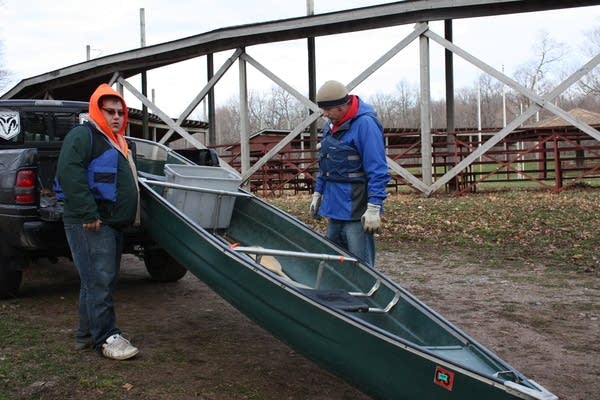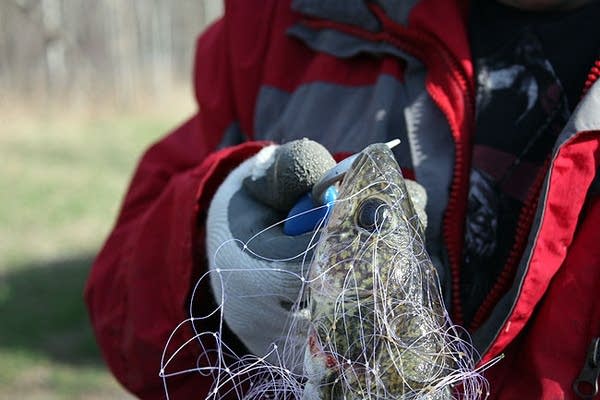Netting is family tradition at Lake Mille Lacs
Go Deeper.
Create an account or log in to save stories.
Like this?
Thanks for liking this story! We have added it to a list of your favorite stories.

At the crack of dawn, Erik Parsons and his cousin Josh Kalk push their canoe out into Lake Mille Lacs from a particular spot of shoreline that's special to their family. Word has it that their great-grandfather dug out this area with his bare hands in the 1940s. They're about to harvest walleye from nets they set out the previous night.
"My grandma has been out here for her entire life," Parsons says. "My dad and all his uncles have been netting here for their entire lives, and here we're out here doing it again."

The two soon discover that high winds overnight caused sediments and algae to move up into the shallow areas of the lake.
The nets caught more algae than fish. The soggy algae floods the container for the fish. That means the two cousins have to go back to shore and empty the container so that it doesn't weigh down their canoe. Parsons says his net can catch anywhere between 20 and as many as 100 fish.
Turn Up Your Support
MPR News helps you turn down the noise and build shared understanding. Turn up your support for this public resource and keep trusted journalism accessible to all.
"We give them to neighbors and friends," he says. "There are a lot of elders and disabled people as well who don't have the means to go out there and do it, so we can provide for everybody at the same time. These will be gone by the end of the day."
Parsons says netting is particularly important during tough economic times because fish is accessible and nutritious. Parsons says netting started out as an easy way to feed a lot of people, and it's still relevant today.
[image]
"A lot of people worked really hard to make this all possible for us. We'd be foolish not to utilize the resources we have at hand," he says.
The 26-year-old says he doesn't see enough people his age continuing this tradition.
"You don't see a lot of young people exercising their treaty rights," Parsons says. "It'd be nice to see if more people want to get active in it because right now, there are a lot of elders doing it. In the future, we're going to be the ones that need to do it for them."
Those rights are granted under a treaty signed in 1837. They allow Ojibwe tribes to fish, hunt, and gather on ceded land under their own tribal regulations. A number of fishing and landowner groups bitterly opposed a settlement over the treaty. The U.S. Supreme Court upheld those rights in the late 1990s.

Under the Mille Lacs tribal regulations, once Parsons gathers his fish, he has to take it to the band's Department of Natural Resources to get the fish counted, measured and weighed.
Curt Kalk is commissioner of the Mille Lacs DNR. He says older generations of leaders saw their tribes as desolate people with very little resources. Kalk says these leaders had the foresight to make sure that natural resources would continue to be accessible to tribal members.
"They knew they needed resources to survive and eat," Kalk says. "Most people that sit down at the dinner table, their food comes from at least 1,500 miles away. We knew that we didn't have that opportunity a lot of times on the reservation. A lot of times, that whole system didn't even exist."

Kalk says one reason netting was so controversial-- and still is today to a lesser degree -- is that Lake Mille Lacs is a premier fishing lake for walleye. Some people may remember many years ago, one Minnesota tribe struggled to manage its own natural resources.
"Is that going to happen here?" says Kalk. "People have this picture in their head that tribes are wasteful, tribal members don't appreciate value of things. Let's just buy the tribe out and then they won't have to go fishing anymore. Well, that ain't what it was about. There is no amount of money that would replace the resource. There is no amount of money that brings back the culture."
Kalk says the Mille Lacs Band has biologists and tribal elders who help manage natural resources to make sure this way of life can continue for future generations.

So far this netting season, eight Ojibwe bands in Minnesota and Wisconsin have caught a little more than 100,000 pounds of walleye, below this year's total allocation of 126,000 pounds. That's a slight increase over last year, and is based on the health of the walleye population. The Mille Lacs Band has caught nearly 24,000 pounds, close to its total allocation for the year.



